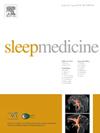中国青少年媒体使用行为类型和内容与睡眠问题的关系
IF 3.4
2区 医学
Q1 CLINICAL NEUROLOGY
引用次数: 0
摘要
电子媒体已经成为青少年日常生活中不可或缺的一部分,然而睡眠问题仍然是一个重要的公共卫生问题。本横断面研究调查了中国青少年媒体使用行为(按类型和内容分类)与睡眠问题之间的关系,重点关注在校日和非在校日及其差异。方法采用匹兹堡睡眠质量指数(PSQI)和媒体使用行为量表对山东省5194名青少年进行问卷调查。使用多元逻辑回归和限制三次样条模型分析相关性。结果在非上学日,使用各种类型和内容的电子媒体(120分钟)与睡眠问题显著相关。不同性别的关联出现了:网上购物主要与女性相关(上学日>;120分钟:OR = 2.486, 95% CI = 1.343-4.604),而网上交流(非上学日>;120分钟:OR = 1.768, 95% CI = 1.284-2.434)和休闲娱乐(非上学日>;120分钟:OR = 2.116, 95% CI = 1.381-3.241)与男性相关。住在校外的青少年在学校媒体使用行为和睡眠问题之间表现出更强的联系。在上学日和非上学日的媒体使用时间差异中观察到非线性剂量-反应关联。结论媒体使用行为与睡眠问题之间的关联因类型和内容而异。基于这些模式,量身定制的干预措施,限制特定的媒体暴露和促进平衡的时间表,可以考虑解决中国青少年的睡眠问题。本文章由计算机程序翻译,如有差异,请以英文原文为准。
Associations of media use behaviors by types and content with sleep problems in Chinese adolescents
Background
Electronic media has become integral to adolescents’ daily lives, yet sleep problems remain a critical public health concern. This cross-sectional study investigated the associations between media use behaviors (by types and content) and sleep problems among Chinese adolescents, with a focus on school days, non-school days and their difference respectively.
Methods
A sample of 5194 adolescents from Shandong Province completed a questionnaire contained the Pittsburgh Sleep Quality Index (PSQI) and a media use behaviors scale. Multivariate logistic regression and restricted cubic spline models were used to analyze the associations.
Results
Excessive use (>120 min) of electronic media across all types and content on non-school days was significantly associated with sleep problems. Sex-specific associations emerged: online shopping was predominantly associated with females (school days >120 min: OR = 2.486, 95 % CI = 1.343–4.604), whereas online communication (non-school days >120 min: OR = 1.768, 95 % CI = 1.284–2.434) and leisure and entertainment (non-school days >120 min: OR = 2.116, 95 % CI = 1.381–3.241) were associated with males. Adolescents living off campus exhibited stronger associations between school-day media use behaviors and sleep problems. Nonlinear dose-response associations were observed for time differences in media use between school and non-school days.
Conclusions
The associations between media use behaviors and sleep problems differ by types and content. Based on these patterns, tailored interventions limiting specific media exposures and promoting balanced schedules may be considered to address sleep concerns in Chinese adolescents.
求助全文
通过发布文献求助,成功后即可免费获取论文全文。
去求助
来源期刊

Sleep medicine
医学-临床神经学
CiteScore
8.40
自引率
6.20%
发文量
1060
审稿时长
49 days
期刊介绍:
Sleep Medicine aims to be a journal no one involved in clinical sleep medicine can do without.
A journal primarily focussing on the human aspects of sleep, integrating the various disciplines that are involved in sleep medicine: neurology, clinical neurophysiology, internal medicine (particularly pulmonology and cardiology), psychology, psychiatry, sleep technology, pediatrics, neurosurgery, otorhinolaryngology, and dentistry.
The journal publishes the following types of articles: Reviews (also intended as a way to bridge the gap between basic sleep research and clinical relevance); Original Research Articles; Full-length articles; Brief communications; Controversies; Case reports; Letters to the Editor; Journal search and commentaries; Book reviews; Meeting announcements; Listing of relevant organisations plus web sites.
 求助内容:
求助内容: 应助结果提醒方式:
应助结果提醒方式:


